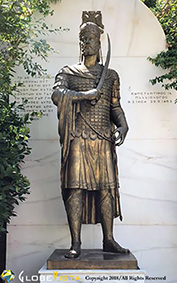Constantine XI Palaiologos statue

Public Art: Constantine XI Palaiologos statue (copy)
Nickname: Marble Emperor
Sculptor: © Spiros Gongakis (1923 – 2001)
Date Unveiled: Unveiled in 1990
Description: A 2.5m high copper statue of the last Byzantine emperor, Constantine XI Palaiologos. The statue is a copy of his 1978 statue of Constantine in Mystras. Constantine is depicted in full armour, holding his sword proudly across his chest.
Location: The statue of Constantine XI Palaiologos stands in the Mitropoleos Square, Athens, Greece
Who Was Constantine XI Palaiologos? : Often referred to as the Marble Emperor, Constantine XI Palaiologos, was the last of the Byzantine Emperors. His greatest and final actions of defending the city of Constantinople placed him in Greek folklore forever.
Constantine was born in 1405 in Constantinople. He was one of ten children born to Manuel II Palaiologos and Helena Dragaš.
When Constantine’s brother, Emperor John VIII Palaiologos died childless, a fight erupted over the throne. Constantine and his brother Demetrios both wanted to reign as the Emperor of the Byzantine Empire (East Roman Empire). In the end, the stalemate was decided by the Ottoman (Turkish) Sultan Murad II who voted in favour of Constantine. All was going along quite fine until the death of Sultan Murad in 1451. Enter his teen son Mehmed II, who was obsessed with the conquest of Constantinople. Despite Constantine’s efforts in thwarting this young little Sultan, Mehmed began building fortresses and cutting off communication. It was becoming clear a siege was imminent.
Unfortunately for Constantine, the Byzantine economy was in an awful state. He tried as best he could to stockpile food and repair the old Theodosian walls in preparation for the Ottoman attack. However, as far as building a decent army to defend the Ottomans was concerned, Constantine had no hope. In desperation, he appealed to the West for military assistance. They would only proceed if a union of Eastern and Roman Churches was signed. This did not go down well with Constantine’s chief minister and military commander, who supposedly responded with, “Better to see the turban of the Turks reigning in the centre of the City than the Latin mitre.” Even his brothers in Morea were too busy fighting their own battles, orchestrated by the Ottomans, to offer any help. Basically, Constantine had been outsmarted at every turn.
In 1452, prior to the siege, 21-year-old Mehmed II made Constantine XI one last offer. Give up Constantinople and I will spare you your life. Constantine’s response was, ‘To surrender the city to you is beyond my authority or anyone else’s who lives in it, for all of us, after taking the mutual decision, shall die of our own free will without trying to save our lives.’
That winter, on 6th April 1453, with a population of 50,000 and an army of 7,000, the city of Constantinople was forced to defend itself against a well-armed Ottoman army of over 70,000 men.
During the 53 days of continual bombardment with state-of-the-art cannon weaponry, Constantine continued to defend alongside his troops. On May the 29th, 1453 the walls of the city were breached. Constantine, for the final time, led the charge. Neither he nor his entourage survived. There were no eyewitnesses to his death.
As the story goes, when Constantine realised his city was about to fall, he tore off all of his imperial clothing and ornaments before leading the last charge so he could not be distinguished from any other soldier. This act proved very foresightful. When Mehmed sent his soldiers to search for Constantine’s body, so it could be paraded through the captured city, they were unable to identify him. In a desperate attempt, a body was found with silk stockings (bearing an eagle emblem). It was taken to the city centre and declared to be that of Emperor Constantine. The body was promptly decapitated and marched through the streets. Those who witnessed this gruesome display denied it was that of Constantine. This spawned the legend of the Marble Emperor.
Marble Emperor Legend: As the legend goes, as the Ottoman Army entered the city of Constantinople an angel appeared. The angel embraced Constantine and turned him into a beautiful marble statue. The statue was hidden in a cave under the Golden Gate. There it remains until the day the Emperor is bought back to life so he can reclaim the city for the Christians.
Things You May Not Know About Emperor Constantine II :
Though Constantine XI has never been canonized he is considered a saint by some churches.
No one knows what Constantine XI Palaiologos looked like as there is no known image of him.
Acknowledgements: Thank you to Kristen Montague for kindly providing the photographs.